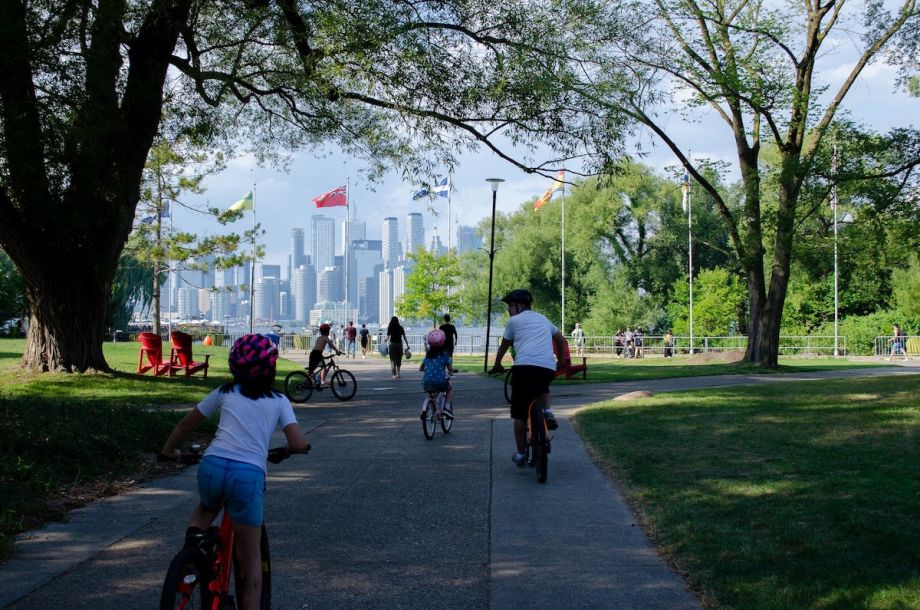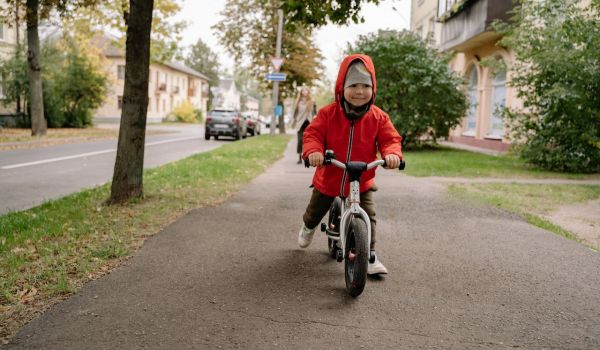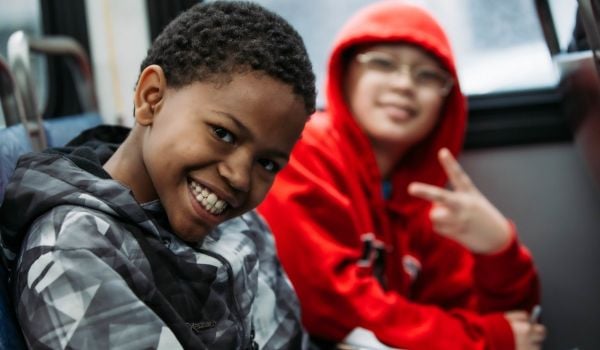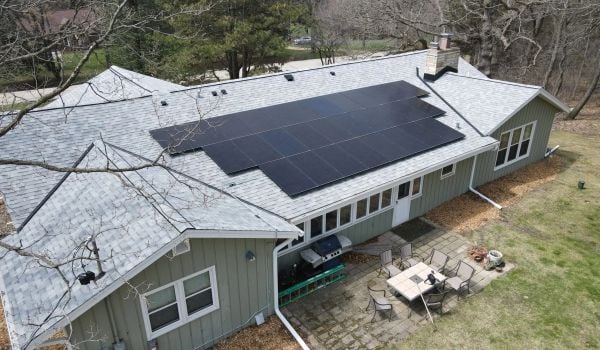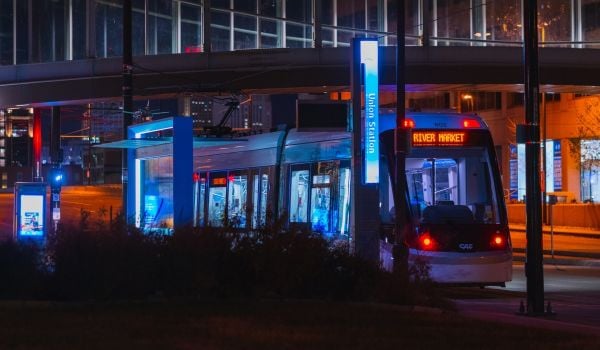This story was originally published by Virginia Mercury.
“When I was a kid, I walked three miles to school uphill both ways.” The phrase has become a shorthand for older generations’ tendency to embellish the hardship of their youth. But despite its joking nature, the idiom contains a kernel of truth.
Whereas today 86% of adults report that their parents walked to school growing up and 61% attest to walking to school themselves as a kid, only 10% say that the children in their family today walk to school. Aiming to reverse this trend, a new wave of parents and educators are advocating for “bike buses” to get their kids off of the school bus or out of the backseat and into the fresh air as a healthier, more social alternative to the driving-dominated school run.
¿Qué es un bicibús?
When her children’s school district began limiting the number of kids allowed on each bus to help prevent the spread of COVID-19, Gillian Burgess decided it was time to break out the family’s bikes. As the founder of Arlington’s monthly Kidical Mass rides, Burgess is no stranger to leading large groups of parents and children on group bike rides. One day a week for the past two years, a couple dozen students and a handful of parents gather and bike to Key Elementary School, cheered on by waving neighbors.
“All the research bore out that the kids were happier, healthier and arriving at school ready to learn,” said Burgess. “When you’re a parent, it’s very easy to get lost in this role and just turn into a chauffeur, so biking with them to school was also better for my mental health to be outside and feel like I was in charge of what was going on in my kid’s life rather than just driving them around everywhere.”
After Burgess learned of Barcelona’s “bicibús” network of more than 1,200 kids riding 90-plus routes to over 70 schools across 25 cities in Catalonia, she renamed her own bike bus in a show of solidarity as well as a wink to the language immersion program at her children’s school. Over the years, Arlington’s bicibús has won support from county officials and added on two new stops for families who live even farther away from the school.
Still, many barriers remain. A lack of signalized crossings around Key Elementary, the bike bus’ reliance upon parents’ ability to volunteer their time and the elimination of a fully funded Safe Routes to School coordinator position by Arlington Public Schools leave Burgess discouraged that the bicibús model can expand within the county to serve more students.
“While bike buses are fun, they are a disappointing symptom of our transportation system,” she said. “The issue is that it is not safe for kids to bike to school on their own. I would much prefer that kids were just able to safely bike to school without adults having to volunteer their time to make sure they get there in one piece.”
Walking the walk
In Richmond — a city where one in five residents live in poverty, the first barrier to bike buses is many students’ lack of access to a functional bike.
“The kids who are riding in bike buses are typically well-resourced with nice bicycles that look well-maintained,” explained Tara Fitzpatrick, the city’s Safe Routes to School coordinator. “These are things that can be prohibitive for kids here in Richmond. Oftentimes something small like a flat tire can become a big barrier. Parents may not have the funds or the knowhow to get that bike fixed, and so many parts of the city don’t have a repair shop at all.”
A few schools pulled off bike bus events last May for National Walk, Bike & Roll to School Day, but Virginia’s capital school district so far doesn’t have a single regular group ride. To make bike buses possible, Fitzpatrick has helped get bicycle repair stands installed at several schools and advocated for adequate bike racks at every Richmond public school.
“Some schools only have the obsolete tire-bender kind of racks,” she explained. “So kids who were biking to Chimborazo Elementary kept having their bikes stolen while they were in class.”
To overcome the obstacles to bike buses, Fitzpatrick is working on reestablishing Richmond’s walking school buses — a door-to-door pickup system where chaperones walk with kids to school — which allow even underresourced kids a healthier way to commute. She hopes to set up a walking school bus at Ginter Park Elementary next year to help boost students’ attendance.
A walking school bus program at Fairfield Court Elementary that ran from 2017 to 2019 saw a 70% reduction in absenteeism, according to Fitzpatrick. There isn’t much data on the attendance impacts of walking school buses, but a similar Massachusetts program documented a 15% decrease in chronic absenteeism.
“When you have kids that are walking together every day, that becomes just a fun thing to do and a habit,” said Fitzpatrick. “Teachers told us students were showing up to school more engaged, with better behavior and improved interpersonal relationships. Walking school buses are a simpler option that work well in dense communities.”
Pay the parents
Bike buses exploded into the national consciousness last year thanks to the viral videos of one physical education teacher in Portland, Oregon. Featuring dozens of kids riding alongside a handful of parent chaperones, Sam Balto’s weekly bike bus at Alameda Elementary quickly had parents across the country asking how to set up school-run bike rides of their own.
The biggest barrier to building out the bike bus model is funding, according to Balto.
“Relying on volunteers to lead bike buses is inequitable and unsustainable,” Balto told the Mercury. “Parents working multiple jobs to make ends meet cannot volunteer their time. They should be compensated for taking the time to do this.”
That’s why Balto is advocating for legislation in Oregon that would allow flexibility in student transportation funding so that schools could choose to spend a portion of their budget on stipends for parents who lead walking or bike buses. Such active transportation to schools isn’t currently possible in many communities where safe sidewalks and protected bike lanes do not exist, but he is adamant that where bike buses are possible they should be implemented and parents should be paid.
“We have the knowhow and the money in our transportation system to give children bikes, to create safe infrastructure and to provide bike storage,” said Balto. “We just don’t have the political will to do it. Every state in our country has a billion-dollar highway widening project. If you had just 1% of Virginia’s highway widening budget, this would be easy.”
Fairfax County Public Schools — the country’s 10th largest school district — devotes more than $180 million annually to school buses alone, the single highest spending on student transportation in the nation.
“That is a failure, not a success,” Balto said. “If we had designed our communities better, we could spend that money on more teachers, better facilities and more art programs and not just waste all that funding on an incredibly expensive form of transportation that only runs twice a day.”
The potential financial benefits from expanding bike buses are not lost on Burgess either: “Enabling children to walk and bike to school instead of paying professionals to drive them could save the county a ton of money,” she said.
Although no bill has yet been filed in Virginia to allow schools to pay parents to accompany kids walking or biking to and from school, it’s an idea that local advocates like Fitzpatrick hope lawmakers will support.
“If we could compensate community members for getting kids to school safely the same way we compensate school bus drivers and crossing guards, then we could alleviate the need for so many school bus drivers and parents using their personal vehicles for drop-offs,” she said. “Walking school buses and bike buses could fill a lot of gaps and help kids get to school in a more communal way.”

Wyatt Gordon is a born-and-raised Richmonder with a master’s in urban planning from the University of Hawai‘i at Mānoa and a bachelor’s in international political economy from the American University in Washington, D.C. He currently covers transportation, housing, and land use for the Virginia Mercury. He also works as a policy and campaigns manager for land use and transportation at the Virginia Conservation Network. Wyatt is a proud Northsider you can find walking, biking, and taking the bus all over town.

